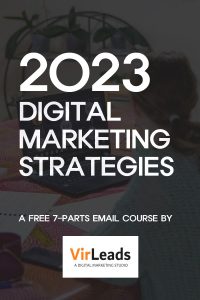"The Perfect Content Marketing Strategy for Lead Generation: Craft Your Way to Lead Generation Success with the Perfect Content Marketing Strategy"
Introduction
Content Marketing is a tried-and-true lead generation approach for businesses of all sizes and sectors. Organizations may attract and keep potential consumers and promote profitable behaviors by creating and providing high-quality content that is personalized to a specific audience. This method entails understanding the audience's needs and developing content that fulfills those needs while establishing trust and authority with them. A tailored and interesting Content Marketing strategy can help potential customers form strong relationships, improving the likelihood of conversion and loyalty. Best of all, Content Marketing is a low-cost lead generating strategy that is extensively used by firms looking to expand their marketing efforts.
How to Use Content Marketing to Generate Leads
Using Content Marketing to generate leads for your organization is an effective strategy. Potential clients might be attracted and engaged by creating and sharing relevant content with your target audience. Content Marketing may help you develop strong relationships with potential consumers, raise brand awareness, and ultimately drive more leads.
Here are some tips for using Content Marketing to generate leads:
Identify Your Target Audience: Before you start creating content, it’s important to identify who your target audience is. This will help you create content that is tailored to their needs and interests.
Create Quality Content: Quality content is essential for Content Marketing success. Make sure your content is well-written, informative, and engaging.
Promote Your Content: Once you’ve created content, you need to promote it. Use social media, email, and other channels to get your content in front of your target audience.
Use Calls-to-Action: Calls-to-action are an important part of Content Marketing. Make sure to include calls-to-action in your content that encourage readers to take the next step, such as signing up for your newsletter or downloading an eBook.
Track Your Results: Tracking your results is essential for understanding what content is working and what isn’t. Use analytics tools to track the performance of your content and adjust your strategy accordingly.
Using the above tips as a guide, you can use Content Marketing to generate leads for your business.

The Benefits of Content Marketing for Lead Generation
Content Marketing has become a critical component of any successful Digital Marketing strategy, and for good reason. It can be an incredibly effective tool for lead generation, attracting potential customers, and guiding them through the buying process.
Here are some of the key benefits of Content Marketing for Lead Leneration:
Attracting Relevant Traffic: By creating high-quality, informative, and engaging content, you can attract relevant traffic to your website. By targeting keywords and topics that your target audience is searching for online, you can improve your website's visibility and attract more visitors who are actively seeking products or services like yours.
Establishing Credibility and Trust: Content can help establish your business as a credible and trustworthy source in your industry. By creating content that addresses common questions and concerns, you can demonstrate your expertise and build trust with potential customers. This can increase the likelihood of generating leads and converting them into customers.
Supporting Lead Nurturing: Content can play a critical role in lead nurturing, which involves engaging potential customers and guiding them through the buying process. By creating content that addresses the needs and interests of your target audience at different stages of the buying process, you can build relationships with potential customers and increase the likelihood of generating leads.
Providing Value to Visitors: Content can provide value to your website visitors by addressing their needs and interests. By creating high-quality, informative, and engaging content, you can establish your website as a credible source of information in your industry. This can encourage visitors to spend more time on your website, increasing the likelihood of generating leads.
Building Backlinks: Content can attract high-quality backlinks from other websites, which can improve your website's authority and visibility. By creating high-quality, shareable content, you can attract backlinks from reputable and relevant websites, improving your website's search engine ranking and generating more leads.
Cost-Effective: Content Marketing is a cost-effective tool for lead generation. By creating evergreen content that can continue to attract traffic and generate leads over time, you can achieve a high return on investment compared to other forms of marketing.
Content Marketing is a powerful tool for lead generation. By attracting relevant traffic, establishing credibility and trust, supporting lead nurturing, providing value to visitors, building backlinks, and being cost-effective, content marketing can help you attract potential customers and convert them into leads. When crafting your content marketing strategy, it's essential to create high-quality, relevant, and engaging content that addresses the needs and interests of your target audience.
Crafting the Perfect Content Marketing Strategy for Lead Generation

Crafting the perfect Content Marketing strategy for lead generation can be a daunting task, but with careful planning and execution, it can be a highly effective way to attract potential customers and guide them through the buying process.
Here are some key steps to follow when crafting your Content Marketing strategy for Lead Generation.
Define Your Target Audience: The first step in crafting a successful Content Marketing strategy for Lead Generation is to define your target audience. This involves identifying the needs, interests, and pain points of your ideal customers, as well as understanding their demographics and online behavior.
Choose Your Content Formats: Once you have identified your target audience, the next step is to choose the content formats that will best engage and inform them. This may include blog posts, videos, social media posts, infographics, e-books, webinars, and more.
Conduct Keyword Research: Keyword research is a critical component of any successful Content Marketing strategy for Lead Generation. By identifying the keywords and phrases that your target audience is searching for online, you can create content that is optimized for search engines and attracts relevant traffic to your website.
Develop a Content Calendar: A content calendar is a schedule of the content you plan to publish and when. This can help you stay organized, ensure that you are consistently publishing high-quality content, and guide your content creation efforts.
Create High-Quality Content: When creating content, it is important to focus on quality over quantity. Your content should be well-researched, well-written, and engaging. This involves creating content that is informative, engaging, and relevant to your target audience's needs and interests.
Promote Your Content: Promoting your content is critical for reaching a wider audience and generating leads. This may involve sharing your content on Social Media, Email Marketing, influencer outreach, and more.
Measure and Analyze Results: Measuring and analyzing the results of your Content Marketing efforts is critical for identifying what is working and what is not. This can help you refine your strategy, improve your content, and optimize your Lead-Generation efforts.
By following these steps, you can create a successful Content Marketing strategy that attracts potential customers, guides them through the buying process, and generates leads for your business.
How to Measure the Success of Your Content Marketing Lead Generation Efforts
Measuring the success of your Content Marketing lead generation efforts is essential for understanding the effectiveness of your campaigns and for making informed decisions about future strategies.
Here are some key metrics to consider:
Conversion Rate: This metric measures the percentage of visitors to your website who take a desired action, such as signing up for a newsletter or downloading a white paper. A higher conversion rate indicates that your content is resonating with your target audience and is effective at driving leads.
Lead Quality: This metric measures the quality of the leads generated by your Content Marketing efforts. Quality leads are those that are more likely to convert into customers. You can measure lead quality by looking at factors such as the number of leads that have engaged with your content, the number of leads that have completed a purchase, and the number of leads that have become repeat customers.
Engagement Rate: This metric measures the level of engagement with your content. It can be measured by looking at the number of views, shares, and comments on your content. A higher engagement rate indicates that your content is resonating with your target audience and is effective at driving leads.
Cost Per Lead: This metric measures the cost of acquiring each lead. It can be calculated by dividing the total cost of your Content Marketing efforts by the number of leads generated. A lower cost per lead indicates that your Content Marketing efforts are more cost-effective.
Tips for Creating Engaging Content for Lead Generation
Developing engaging content is an important component of lead generation since it may help you attract and convert potential clients. Here are some pointers for developing both informed and entertaining content:
Quality should be prioritized: Your content should be well-researched, accurate, and relevant to your target audience. This will help to build your brand as a reliable authority in your sector and encourage people to interact with your material.
Use Visuals: Images, videos, and infographics can help break up text and make your material more interesting and understandable. Select visuals that are both relevant to your content and visually appealing.
Incorporate Calls-to-Action: Calls-to-action (CTAs) are critical for lead generation. Include CTAs throughout your content to urge readers to take the next step in the lead generation process, such as filling out a form or contacting your organization.
Optimize for Search Engines: Optimizing your content for search engines can help you reach a larger audience and generate more leads. Use relevant keywords in your content and meta tags, and make sure your website is mobile-friendly and loads quickly.
Use Social Media: Social media is a wonderful tool for promoting your content and reaching a broader audience. Share your material on social media and engage with your fans to establish relationships and trust.
Offer Incentives: Incentives such as discounts, free trials, or unique material can assist motivate readers to take action and become leads. you enhance their impact, make sure you advertise these incentives across your content and on your website.
Following these guidelines will allow you to design content that is both entertaining and successful for lead generation. To maximize your results, remember to focus on quality, employ images, add CTAs, optimize for search engines, leverage social media, and offer incentives.
Conclusion
Content Marketing is no longer a passing fad for businesses trying to generate leads and expand their consumer base. Businesses may generate unique and personalized content that resonates with their target audience with the right Content Marketing approach. This not only aids in the development of long-term connections and trust with potential customers, but it also raises brand awareness and exposure, resulting in more leads and conversions. Businesses may efficiently attract the attention of their target audience and drive more qualified leads to their sales funnel by producing content that is relevant, useful, and entertaining.


